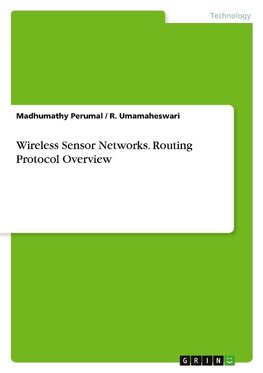
-
 Anglický jazyk
Anglický jazyk
Wireless Sensor Networks. Routing Protocol Overview
Autor: Madhumathy Perumal
Document from the year 2020 in the subject Engineering - Computer Engineering, , language: English, abstract: Sensor nodes have restricted storage, computational and energy resources, these restrictions place a limit on the types of deployable routing mechanisms.... Viac o knihe
Na objednávku, dodanie 2-4 týždne
44.37 €
bežná cena: 49.30 €
O knihe
Document from the year 2020 in the subject Engineering - Computer Engineering, , language: English, abstract: Sensor nodes have restricted storage, computational and energy resources, these restrictions place a limit on the types of deployable routing mechanisms. Routing protocol disseminates information that enables the sensor nodes to select routes to communicate with other nodes on the network and the choice of the route is determined by the routing algorithms. Thus the routing protocol helps the nodes to gain knowledge about the topology of the network to which it is attached directly.
There are mainly two types of routing processes: one is static routing and the other is dynamic routing. In a static routing, the routing tables are set up in a static manner in the nodes. The network routes for the packet are initially set between the nodes. However, if any node on the specified route fails, the data may not reach the destination. In a dynamic routing, routing tables in the routers often change whenever the possible routes change. Dynamic routing is more suitable as the nodes in WSNs may frequently change their position and die at any moment.
The routing protocols are classified into single hop and multi hop routing. In a single hop routing, sensor node directly communicates with the sink to share the gathered information. Energy consumption is high in the network using single hop protocol. In multi hop routing, data is routed through the intermediate nodes to the base station. Each node transfers sensed data to the immediate node which in turn transfers the data to the next immediate node and finally the data reaches the base station. Energy consumption in this kind of routing protocol is less and thus the lifetime of the nodes is high.
The major challenge to the efficient operation of wireless sensor network lies in its ability to deliver the sensed information from the nodes to the sink within the specific time duration without the loss of data packets with high security. The sensor nodes depend on the battery source for their operation which has limited capacity. Thus the energy resource of the sensor nodes has to be used efficiently in order to increase the operational lifetime of the network.
- Vydavateľstvo: GRIN Verlag
- Rok vydania: 2021
- Formát: Paperback
- Rozmer: 210 x 148 mm
- Jazyk: Anglický jazyk
- ISBN: 9783346315571



 Nemecký jazyk
Nemecký jazyk 







